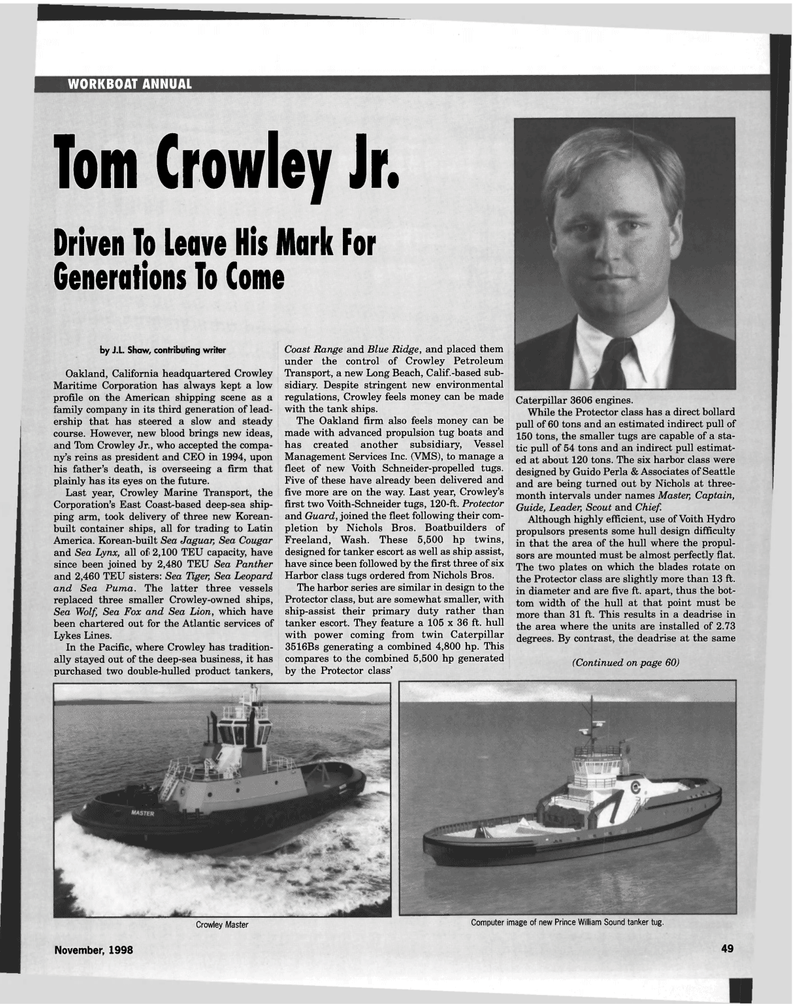
Page 49: of Maritime Reporter Magazine (November 1998)
Read this page in Pdf, Flash or Html5 edition of November 1998 Maritime Reporter Magazine
WORKBOAT ANNUAL
Crowley Master Computer image of new Prince William Sound tanker tug.
Tom Crowley Jr.
Driven To Leave His Mark For
Generations To Come by J.L. Shaw, contributing writer
Oakland, California headquartered Crowley
Maritime Corporation has always kept a low profile on the American shipping scene as a family company in its third generation of lead- ership that has steered a slow and steady course. However, new blood brings new ideas, and Tom Crowley Jr., who accepted the compa- ny's reins as president and CEO in 1994, upon his father's death, is overseeing a firm that plainly has its eyes on the future.
Last year, Crowley Marine Transport, the
Corporation's East Coast-based deep-sea ship- ping arm, took delivery of three new Korean- built container ships, all for trading to Latin
America. Korean-built Sea Jaguar, Sea Cougar and Sea Lynx, all of 2,100 TEU capacity, have since been joined by 2,480 TEU Sea Panther and 2,460 TEU sisters: Sea Tiger, Sea Leopard and Sea Puma. The latter three vessels replaced three smaller Crowley-owned ships,
Sea Wolf, Sea Fox and Sea Lion, which have been chartered out for the Atlantic services of
Lykes Lines.
In the Pacific, where Crowley has tradition- ally stayed out of the deep-sea business, it has purchased two double-hulled product tankers,
Coast Range and Blue Ridge, and placed them under the control of Crowley Petroleum
Transport, a new Long Beach, Calif.-based sub- sidiary. Despite stringent new environmental regulations, Crowley feels money can be made with the tank ships.
The Oakland firm also feels money can be made with advanced propulsion tug boats and has created another subsidiary, Vessel
Management Services Inc. (VMS), to manage a fleet of new Voith Schneider-propelled tugs.
Five of these have already been delivered and five more are on the way. Last year, Crowley's first two Voith-Schneider tugs, 120-ft. Protector and Guard, joined the fleet following their com- pletion by Nichols Bros. Boatbuilders of
Freeland, Wash. These 5,500 hp twins, designed for tanker escort as well as ship assist, have since been followed by the first three of six
Harbor class tugs ordered from Nichols Bros.
The harbor series are similar in design to the
Protector class, but are somewhat smaller, with ship-assist their primary duty rather than tanker escort. They feature a 105 x 36 ft. hull with power coming from twin Caterpillar 3516Bs generating a combined 4,800 hp. This compares to the combined 5,500 hp generated by the Protector class'
Caterpillar 3606 engines.
While the Protector class has a direct bollard pull of 60 tons and an estimated indirect pull of 150 tons, the smaller tugs are capable of a sta- tic pull of 54 tons and an indirect pull estimat- ed at about 120 tons. The six harbor class were designed by Guido Perla & Associates of Seattle and are being turned out by Nichols at three- month intervals under names Master, Captain,
Guide, Leader, Scout and Chief.
Although highly efficient, use of Voith Hydro propulsors presents some hull design difficulty in that the area of the hull where the propul- sors are mounted must be almost perfectly flat.
The two plates on which the blades rotate on the Protector class are slightly more than 13 ft. in diameter and are five ft. apart, thus the bot- tom width of the hull at that point must be more than 31 ft. This results in a deadrise in the area where the units are installed of 2.73 degrees. By contrast, the deadrise at the same (Continued on page 60)
November, 1998 49

 48
48

 50
50
